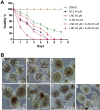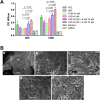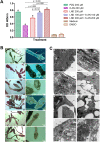In vitro effects of lonidamine and 6-aminonicotinamide against Echinococcus granulosussensu stricto and Echinococcus multilocularis
- PMID: 32101153
- PMCID: PMC7045558
- DOI: 10.1186/s13567-020-00744-6
In vitro effects of lonidamine and 6-aminonicotinamide against Echinococcus granulosussensu stricto and Echinococcus multilocularis
Abstract
Echinococcosis is a zoonotic disease caused by cestode species of the genus Echinococcus, which demonstrates considerable medical and veterinary concerns. The development of novel drugs for echinococcosis treatment is urgently needed. In this study, we demonstrated that lonidamine (LND) and 6-aminonicotinamide (6-AN) exhibited considerable in vitro effects against both larval- and adult-stage of E. granulosussensu stricto (s. s.) and E. multilocularis. The combination of LND and 6-AN exhibited a significantly higher activity than the single drug treatment. These results highlight the therapeutic potential of LND, 6-AN and the combination of LND and 6-AN for the treatment of echinococcosis.
Conflict of interest statement
The authors declare that they have no competing interests.
Figures



Similar articles
-
Effect of anacardic acid against echinococcosis through inhibition of VEGF-induced angiogenesis.Vet Res. 2019 Jan 14;50(1):3. doi: 10.1186/s13567-019-0621-7. Vet Res. 2019. PMID: 30642401 Free PMC article.
-
In vitro efficacy of ampelopsin against Echinococcus granulosus and Echinococcus multilocularis.J Vet Med Sci. 2019 Dec 26;81(12):1853-1858. doi: 10.1292/jvms.19-0347. Epub 2019 Nov 19. J Vet Med Sci. 2019. PMID: 31748438 Free PMC article.
-
In vitro and in vivo effects of 3-bromopyruvate against Echinococcus metacestodes.Vet Res. 2019 Nov 19;50(1):96. doi: 10.1186/s13567-019-0710-7. Vet Res. 2019. PMID: 31744550 Free PMC article.
-
Therapeutic efficacy of nanocompounds in the treatment of cystic and alveolar echinococcoses: challenges and future prospects.Parasitol Res. 2019 Sep;118(9):2455-2466. doi: 10.1007/s00436-019-06416-5. Epub 2019 Aug 11. Parasitol Res. 2019. PMID: 31402401 Review.
-
Benzimidazoles for the treatment of cystic and alveolar echinococcosis: what is the consensus?Expert Rev Anti Infect Ther. 2009 Mar;7(2):145-9. doi: 10.1586/14787210.7.2.145. Expert Rev Anti Infect Ther. 2009. PMID: 19254162 Review. No abstract available.
Cited by
-
2-Deoxy-D-glucose and combined 2-Deoxy-D-glucose/albendazole exhibit therapeutic efficacy against Echinococcus granulosus protoscoleces and experimental alveolar echinococcosis.PLoS Negl Trop Dis. 2022 Jul 18;16(7):e0010618. doi: 10.1371/journal.pntd.0010618. eCollection 2022 Jul. PLoS Negl Trop Dis. 2022. PMID: 35849619 Free PMC article.
-
Suppressive effect of pseudolaric acid B on Echinococcus multilocularis involving regulation of TGF-β1 signaling in vitro and in vivo.Front Microbiol. 2022 Nov 11;13:1008274. doi: 10.3389/fmicb.2022.1008274. eCollection 2022. Front Microbiol. 2022. PMID: 36439797 Free PMC article.
-
Chemotherapy for the treatment of alveolar echinococcosis: Where are we?Parasite. 2024;31:56. doi: 10.1051/parasite/2024055. Epub 2024 Sep 23. Parasite. 2024. PMID: 39311470 Free PMC article. Review.
-
Antiparasitic activity of the steroid-rich extract of Schima wallichii against poultry cestode.Vet World. 2024 Jun;17(6):1299-1306. doi: 10.14202/vetworld.2024.1299-1306. Epub 2024 Jun 19. Vet World. 2024. PMID: 39077457 Free PMC article.
References
MeSH terms
Substances
Grants and funding
LinkOut - more resources
Full Text Sources

